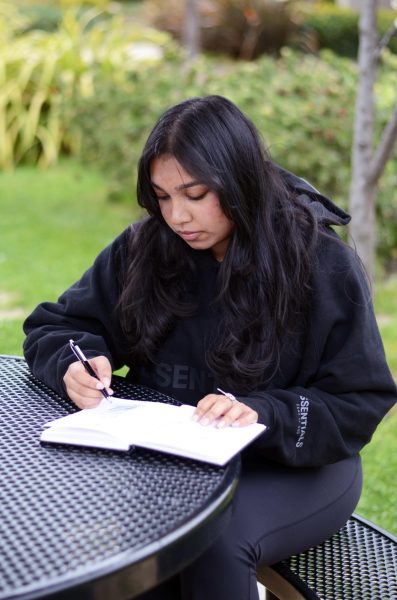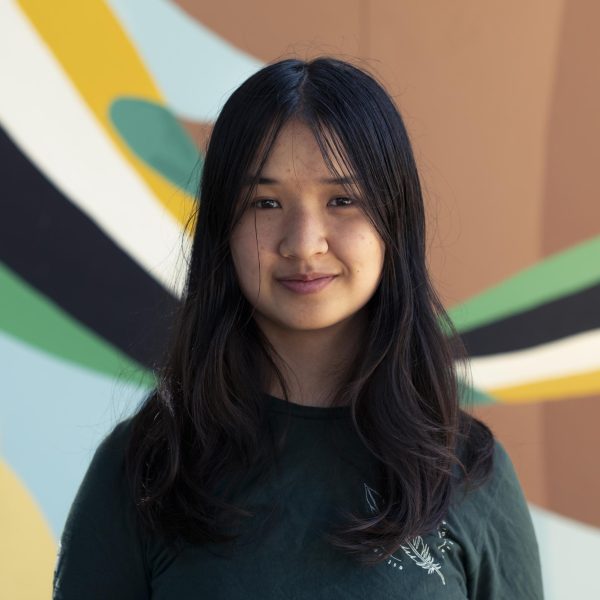
A film of polaroid ink glistens on the water’s surface. Serena Janny (12) adjusts the picture with a fine paintbrush before picking up a rose petal and slowly submerging it into the warm water. As she lifts the rose petal and attached image out of the water, the ink stretches and distorts to fit its new, curved canvas.
Growing up in Silicon Valley, Serena has always been surrounded by technology. After learning to code in her freshman year, she learned more about AI through summer camps. She has used this knowledge to research a variety of subjects, such as predicting crop growth and detecting brain cancers, but her favorite project has been creating her own ethical AI art generator by using her own artwork as input.
Serena has also always been interested in the arts. In high school, she seized the opportunity to explore this passion more deeply through volunteering and high school art classes such as honors directed portfolio.
“It’s a really neat class because you get a lot of freedom to do what you want, which you don’t really get with a lot of classes,” Serena said. “So I was able to try a lot of different things. I tried sculpture and 3-D art for the first time. It was just really interesting because I feel like a lot of like other art classes I’ve taken for like AP and stuff were really structured, but in this class, students could decide what they wanted to do, which was really interesting.”
One of her favorite works is a multimedia piece using rose petals and Polaroid ink. She often uses her art to express her thoughts and experiences, and in this piece she explored the uncertainty of the future.
“Rose petals and the Polaroid ink are both very fragile elements,” Serena said. “The images I used were inspired by the future and possibilities of the future. All of these are very fragile ideas. Juxtaposing those to the material and those ideas was inspired by my thinking about the future and how uncertain everything was. I was doing this before I got college decisions back and it’s a very tricky time because you can’t see what path your future is going to go in. ”
Close friend Sydney Ling (12) adds that in addition to Serena’s own explorations within art, she also uses her talents to help others in various fields, such as through STEM.
“We did summer school together at Harker,” Sydney said. “It was like Honors Algebra Two Trig. And that was kind of a horrible experience, but she made it better because we were in the same class. We were able to help each other out and also bond over the misery of it. She’s definitely supportive. And since we typically only have STEM classes together and she’s better at STEM than me, she’d always answer my questions or send me her notes or explain different concepts and questions. And we still do that like this year.”
While Serena enjoys art as a mode of expressing herself, she also views computer science as complementary, allowing her to have a larger impact on the world.
“My favorite thing about art would be that it is very freeing,” Serena said. “I’m more of a reserved person, so it’s not as easy for me to start talking to random people about random things, but my artwork is a way that I can do that because my artwork is essentially my voice and the way that I can express myself. For engineering and computer science, [my favorite part] is being able to combine it with my other interests because technology has so much potential. A lot of what motivates me is the potential for something bigger in the future or something that could potentially create a lot of change.”
One of the ways Serena hopes to create an impact is through creating ethical AI art models. After taking courses to learn about image processing and how to create AI models, Serena decided to create a model using her own artwork as the input.
“By using my own artwork for my own project, not infringing on anything, everything’s just involved in itself and it’s entirely my work and that was my initial initial plan,” Serena said. “It’s a lot harder than it seemed to be at first, as everything is. I came up with the idea at the end of sophomore year, I worked with more mentors and ways that I can expand on that ever since. So that’s still a work in process and development, but that’s one of my favorite projects”
One of the ways Serena hopes to amplify her impact through technology is by creating a tool to teach artists technical skills. She plans to achieve this by creating a model trained on works by the old masters, experts in realism.
“You’re able to kind of create a model that has all of the technical skills that an artist would use to render faces,” Serena said. “Ideally, that model will be able to help artists train themselves and help them with their own creative process. Because, of course, part of art beyond just technical skills is the creative process and your own ideas. So I think by using that help with the technical standpoint, artists have a lot more time and freedom to work on their creative process and their thoughts and ideas.”
Jennifer Hargreaves, director of admissions and Serena’s advisor, adds that Serena’s dual passions and unique perspective will aid her in the future.
“She pursued AP art outside of Harker and is doing one here this year,” Hargreaves said. “She takes a lot of those advanced computer science classes but also has this artistic side. I think she has this both sides of her brain type intelligence, and I think that will serve her well in the future.”
Serena’s experiences in both art and STEM inform the way she experiences the other. While she approaches art in a more methodical, systematic manner, she often approaches her engineering projects in a more fluid manner. Through combining them, she is able to find a unique perspective and better express herself and impact the world.
“For a lot of people arts and visual art especially, and engineering and STEM are two very separate things,” Serena said. “And the biggest thing I’ve learned is removing yourself from the mindset. And I think looking at the intersection between different fields of thought, that is where you can see a lot of ideas and potential for the future.”


















![“[Building nerf blasters] became this outlet of creativity for me that hasn't been matched by anything else. The process [of] making a build complete to your desire is such a painstakingly difficult process, but I've had to learn from [the skills needed from] soldering to proper painting. There's so many different options for everything, if you think about it, it exists. The best part is [that] if it doesn't exist, you can build it yourself," Ishaan Parate said.](https://harkeraquila.com/wp-content/uploads/2022/08/DSC_8149-900x604.jpg)




![“When I came into high school, I was ready to be a follower. But DECA was a game changer for me. It helped me overcome my fear of public speaking, and it's played such a major role in who I've become today. To be able to successfully lead a chapter of 150 students, an officer team and be one of the upperclassmen I once really admired is something I'm [really] proud of,” Anvitha Tummala ('21) said.](https://harkeraquila.com/wp-content/uploads/2021/07/Screen-Shot-2021-07-25-at-9.50.05-AM-900x594.png)







![“I think getting up in the morning and having a sense of purpose [is exciting]. I think without a certain amount of drive, life is kind of obsolete and mundane, and I think having that every single day is what makes each day unique and kind of makes life exciting,” Neymika Jain (12) said.](https://harkeraquila.com/wp-content/uploads/2017/06/Screen-Shot-2017-06-03-at-4.54.16-PM.png)








![“My slogan is ‘slow feet, don’t eat, and I’m hungry.’ You need to run fast to get where you are–you aren't going to get those championships if you aren't fast,” Angel Cervantes (12) said. “I want to do well in school on my tests and in track and win championships for my team. I live by that, [and] I can do that anywhere: in the classroom or on the field.”](https://harkeraquila.com/wp-content/uploads/2018/06/DSC5146-900x601.jpg)
![“[Volleyball has] taught me how to fall correctly, and another thing it taught is that you don’t have to be the best at something to be good at it. If you just hit the ball in a smart way, then it still scores points and you’re good at it. You could be a background player and still make a much bigger impact on the team than you would think,” Anya Gert (’20) said.](https://harkeraquila.com/wp-content/uploads/2020/06/AnnaGert_JinTuan_HoHPhotoEdited-600x900.jpeg)

![“I'm not nearly there yet, but [my confidence has] definitely been getting better since I was pretty shy and timid coming into Harker my freshman year. I know that there's a lot of people that are really confident in what they do, and I really admire them. Everyone's so driven and that has really pushed me to kind of try to find my own place in high school and be more confident,” Alyssa Huang (’20) said.](https://harkeraquila.com/wp-content/uploads/2020/06/AlyssaHuang_EmilyChen_HoHPhoto-900x749.jpeg)



